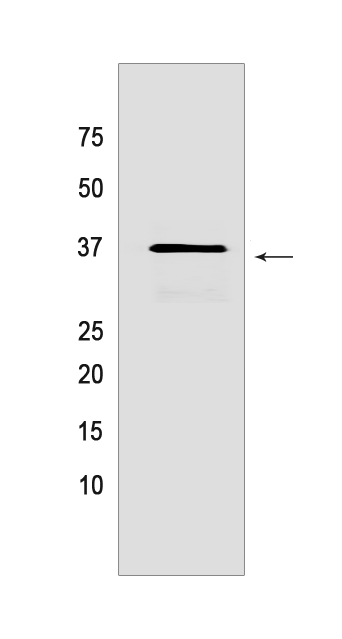ZFP36L1 Mouse mAb[LQ63]Cat NO.: A47986
Western blot(SDS PAGE) analysis of extracts from HUVEC cells.Using ZFP36L1 Mouse mAb IgG [LQ63] at dilution of 1:1000 incubated at 4℃ over night.
Product information
Protein names :ZFP36L1,BERG36,BRF1,ERF1,RNF162B,TIS11B,TISB_HUMAN,mRNA decay activator protein ZFP36L1
UniProtID :Q07352
MASS(da) :36,314
MW(kDa) :36kDa
Form :Liquid
Purification :Protein A purification
Host :Mouse
Isotype :IgG
sensitivity :Endogenous
Reactivity :Human,Rat
- ApplicationDilution
- 免疫印迹(WB)1:1000-2000
- The optimal dilutions should be determined by the end user
Specificity :Antibody is produced by immunizing animals with a synthetic peptide of human ZFP36L1.
Storage :Antibody store in 10 mM PBS, 0.5mg/ml BSA, 50% glycerol. Shipped at 4°C. Store at-20°C or -80°C. Products are valid for one natural year of receipt.Avoid repeated freeze / thaw cycles.
WB Positive detected :HUVEC cells
Function : Zinc-finger RNA-binding protein that destabilizes several cytoplasmic AU-rich element (ARE)-containing mRNA transcripts by promoting their poly(A) tail removal or deadenylation, and hence provide a mechanism for attenuating protein synthesis (PubMed:12198173, PubMed:15538381, PubMed:15467755, PubMed:17030608, PubMed:19179481, PubMed:20702587, PubMed:24700863, PubMed:25106868, PubMed:25014217, PubMed:26542173). Acts as a 3'-untranslated region (UTR) ARE mRNA-binding adapter protein to communicate signaling events to the mRNA decay machinery (PubMed:15687258). Functions by recruiting the CCR4-NOT deadenylase complex and components of the cytoplasmic RNA decay machinery to the bound ARE-containing mRNAs, and hence promotes ARE-mediated mRNA deadenylation and decay processes (PubMed:15687258, PubMed:18326031, PubMed:25106868). Induces also the degradation of ARE-containing mRNAs even in absence of poly(A) tail (By similarity). Binds to 3'-UTR ARE of numerous mRNAs (PubMed:12198173, PubMed:15538381, PubMed:15467755, PubMed:17030608, PubMed:19179481, PubMed:20702587, PubMed:24700863, PubMed:25106868, PubMed:25014217, PubMed:26542173). Positively regulates early adipogenesis by promoting ARE-mediated mRNA decay of immediate early genes (IEGs) (By similarity). Promotes ARE-mediated mRNA decay of mineralocorticoid receptor NR3C2 mRNA in response to hypertonic stress (PubMed:24700863). Negatively regulates hematopoietic/erythroid cell differentiation by promoting ARE-mediated mRNA decay of the transcription factor STAT5B mRNA (PubMed:20702587). Positively regulates monocyte/macrophage cell differentiation by promoting ARE-mediated mRNA decay of the cyclin-dependent kinase CDK6 mRNA (PubMed:26542173). Promotes degradation of ARE-containing pluripotency-associated mRNAs in embryonic stem cells (ESCs), such as NANOG, through a fibroblast growth factor (FGF)-induced MAPK-dependent signaling pathway, and hence attenuates ESC self-renewal and positively regulates mesendoderm differentiation (By similarity). May play a role in mediating pro-apoptotic effects in malignant B-cells by promoting ARE-mediated mRNA decay of BCL2 mRNA (PubMed:25014217). In association with ZFP36L2 maintains quiescence on developing B lymphocytes by promoting ARE-mediated decay of several mRNAs encoding cell cycle regulators that help B cells progress through the cell cycle, and hence ensuring accurate variable-diversity-joining (VDJ) recombination and functional immune cell formation (By similarity). Together with ZFP36L2 is also necessary for thymocyte development and prevention of T-cell acute lymphoblastic leukemia (T-ALL) transformation by promoting ARE-mediated mRNA decay of the oncogenic transcription factor NOTCH1 mRNA (By similarity). Participates in the delivery of target ARE-mRNAs to processing bodies (PBs) (PubMed:17369404). In addition to its cytosolic mRNA-decay function, plays a role in the regulation of nuclear mRNA 3'-end processing,modulates mRNA 3'-end maturation efficiency of the DLL4 mRNA through binding with an ARE embedded in a weak noncanonical polyadenylation (poly(A)) signal in endothelial cells (PubMed:21832157). Also involved in the regulation of stress granule (SG) and P-body (PB) formation and fusion (PubMed:15967811). Plays a role in vasculogenesis and endocardial development (By similarity). Plays a role in the regulation of keratinocyte proliferation, differentiation and apoptosis (PubMed:27182009). Plays a role in myoblast cell differentiation (By similarity)..
Tissue specificity :Expressed mainly in the basal epidermal layer, weakly in the suprabasal epidermal layers (PubMed:27182009). Expressed in epidermal keratinocytes (at protein level) (PubMed:27182009). Expressed in osteoblasts (PubMed:15465005)..
Subcellular locationi :Nucleus. Cytoplasm. Cytoplasmic granule. Cytoplasm, P-body.
IMPORTANT: For western blots, incubate membrane with diluted primary antibody in 1% w/v BSA, 1X TBST at 4°C overnight.


